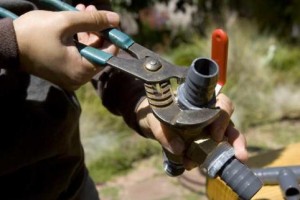California water system in need of major repair

The California Department of Water Resources warned in a December report that 50% of the state’s aging levees are not up to standard and up to $17 billion is needed in repairs and infrastructure investment. This of course comes at a very bad financial time for California, as it is already suffering from huge budget deficits.
There are over 14,000 levees and other structures built along the Sacramento and San Joaquin Rivers. Many were built by local governments or farmers, are decades old, and were built when the areas were mostly rural. That is no longer the case. In many areas now, major urban populations with homes and businesses are on the other side of the levees. This leads to a conundrum. If levees are reinforced and heightened, then even more development might result behind them, increasing the possibility of flood risk in future years.
But, if you lived behind a levee and learned that it would not be strengthened (when perhaps others would be), then you might well protest loudly. The politics of which levees get additional work could become contentious indeed. This also implies that new development needs to take note of the condition of nearby levees and that there may be areas where development shouldn’t happen.
The report is sobering. About half of the urban levees do not meet design criteria for several factors, including stability and underground seepage. In addition, 60% of non-urban levees suffer from similar or related problems. In other words, over half of the levees need work, as do half of the channels. Seepage is the biggest problem, with its relative threat factor rated as High, the only such rating for the entire system. A worrisome half of non-urban levees have a “high potential” of failure from under-seepage, while one-quarter could fail due to through-seepage.
Levees rated as Higher Concern include large portions of the San Joaquin River, starting west of Stockton near Firebaugh and continuing almost to Stockton. Much of the Sacramento River levees beginning north of Sacramento, continuing down to Rio Visto, are also Higher Concern.
The two rivers join in the Sacramento-San Joaquin Delta, where the water wars rage, as agricultural, urban, and fishing interests all compete for what generally isn’t enough water to satisfy everyone. Any major breakages or failures on the levees would be devastating to the delta.
The repairs and upgrades could cost upwards of $17 billion. $5 billion in bond funds have already been approved. An $11 billion bond measure may be on the November ballot. But voters are in such a foul mood that it’s difficult to predict if it would pass. Plus, of course, the money has to be paid back, with interest, and at a time when California sees little end to its financial woes.
The report recommends spending $6 billion in urban areas and another $6 billion in system-wide upgrades. The great fear of agriculture is that they will be mostly left out in water system improvements, while cities get the bulk of the money. Let’s not forget that California agriculture feeds the nation and provides a major source of revenue for the state.
There’s always the possibility of black swans, apparently unexpected events that change everything. Sen. Dianne Feinstein once said:
“I have just one statistic, one only, and that is 25 million people depend on Delta water for the drinking water of the state. And the probability of a big earthquake over 6.7 is 75% in the next 30 years. And if that were to happen, there are all indications that the Delta would collapse, the water would be gone, there would be no water for drinking, there would be no water for agriculture, there would be no water for fish, marsh, ecosystems.”
California somehow needs to fix the levees and water system, and it needs to do it sooner rather than later.
For further reading, water blogs of interest include Aquafornia, California Water Blog, WaterWired, and Aquanomics.




